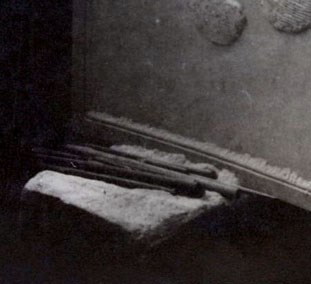|
Three Graces Garden Panel Selmer-Larsen also sculpted a panel of the three graces for the Sandersons' flower garden. During the spring and summer of 1918 he worked on a model out of what appears to be clay. First he carved out the bodies of the graces, then he added the thin dresses over top and more details. Looking closely at a photo of the model reveals that he used pencil to draw out his ideas onto the clay. 
Photo #6218-164, cropped, 1918, Olmsted Archives
The next step was carving the panel out of stone. This was a laborious process requiring many hours of hammering a chisel into the stone, gradually adding finer details. Near the end Selmer-Larsen smoothed out the surface, most likely with a file-like tool. In the photo below, you can see his set up in the barn, and in the detail shot underneath, the chisel marks as he worked. The clay model stood as reference next to the stone slab.

Photo #6218-163, 1918, Olmsted Archives 
Right: Completed panel in place (Photo #6218-147, Olmsted Archives) What Materials did Selmer-Larsen use? 
Photo #6218-163 detail From purchase lists of the Olmsted firm, we know that the modeling department bought materials such as modeling clay, plastilina (a clay with a wax and oil base), plaster, concrete, hammers, engraving tools, and chisels.There were also two ovens in the barn where he worked that may have been used to bake clay. On the left is a close-up from the above photo in the barn. It shows some of Selmer-Larsen's tools.
|
Last updated: February 2, 2022
